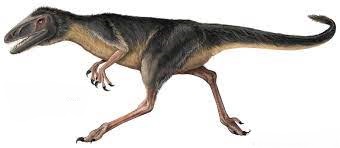
Dilong Dinosaur is an extinct genus of primitive tyrannosauroid dinosaur that lived during the Early Cretaceous Period. This type of dinosaur was among the earliest members of the tyrannosaurid family, which included the much later Tyrannosaurus Rex. It was discovered in the Liaoning Province of China in 2004 and belongs to a group of therapod dinosaurs named coelurosaurs. The genus name, Dilong, means emperor dragon in Chinese. As a therapod, Dilong was bipedal, meaning it had two legs to move itself around quickly with agility. Its body was small in size, with an estimated length of 1.1 meters (3.6 ft) and a weight of between 4.5 to 9 kilograms (10 to 20 pounds).
Its head was small and relatively short, with a relatively large brain cavity compared to other similar-sized therapods. Its teeth were also smaller and not as strongly built as other therapods. The most unique aspect of Dilong was its integument, or skin. It is believed to have had protofeathers, which consisted of short, thick bristles rather than the more typical feathers seen in modern birds. It is thought that these may have been used to regulate temperature or to display social behaviours between individuals. Unlike some other therapod dinosaurs, Dilong did not possess horns or other ornamental features. Dilong had a suite of characteristics that were transitional between those of theropods and the advanced tyrannosauroids.
Dilong Facts :
| Name: | Dilong Dinosaurs |
| Size: | 1.1 meters (3.6 ft) |
| Main Facts: | Dilong was bipedal, meaning it had two legs to move itself around quickly with agility. |
For example, it had trouser-shaped hind legs, which suggests that it was able to climb better than other therapods of the time. It also had a longer, more flexible neck, as well as fingers with opposable thumbs. This may indicate that Dilong was better adapted to grabbing and manipulating prey than other therapods of the time. Although little is known about the behaviour of Dilong, it had several features that suggest it was a carnivore. It had sharp, serrated teeth, as well as several characteristics that would have allowed it to pursue and capture prey more efficiently than other therapods.
For instance, its head was wider than other therapods, which would have allowed it to take larger bites. Dilong is known as the ancestor of the Tyrannosaurus Rex, and the genus has provided important insight into the transition from basal therapods to advanced tyrannosauroids. Its primitive features, such as its protofeathers and finger structure, provide evidence of its place in the therapod fossil record, and help us understand the evolution of therapods. All in all, Dilong's discovery is an important link in our understanding of determinations of therapod evolution, as well as to our understanding of the Tyrannosaurus Rex's ancestral lineage. Although it is now extinct, its legacy lives on in its place in the fossil record, as well as in its contribution to our limited understanding of therapod dinosaurs.